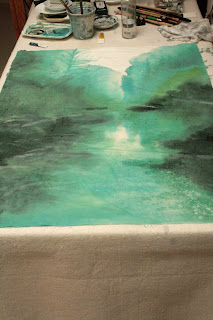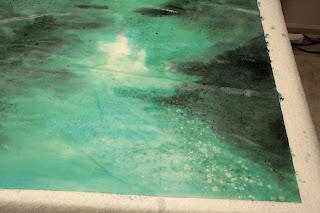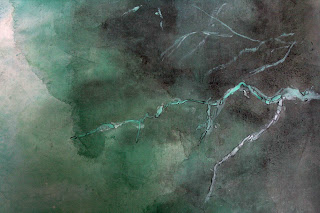I wetted down the Xuan again and allowed it to be 70% dried. I wanted to paint definite shapes without being too discrete and weighted, taking care to insert a few tree spikes. I worked to intensify the banks/reflections and what have you. The repeated brush strokes had taken a toll on the delicate Xuan and lints were everywhere.
As expected, the painting took on a different feel when viewed from the front now. The additional wash/staining on the back of the paper caused the alum specks to be quite visible from the front now. Somehow I was able to confuse the specks to think the front is the back and vice versa ( or was I being confused?). Chalk this up as an unexpected bonus!
Now that I had attained the feel of the painting, I worked to define the landscape and the incidentals. I didn't want to destroy the feeling of reve, so I decided to use the split hair technique to define my shapes with dots, which is what pixels do. This is done with an old brush whose prime has gone and is ready for the waste basket. The surviving beat up bristles are ideal for rendering these random fine dots. Discriminate use of dabbing defined shapes, shades and texture. I wanted to display certain ambiguities with this method; were those shadows or foggy mists? The layering of these pixels of various saturation actually helped create an illusion of depth; allowing a description of spatial relationship and texture of the various features.
My attention now turned to the banks and reflections. I preferred a more defined outline, since I am working with the supposed surface of a body of water. I described that with a darker colored wash, onto the dry Xuan this time. I wanted these brush strokes to leave a distinct mark.








No comments:
Post a Comment